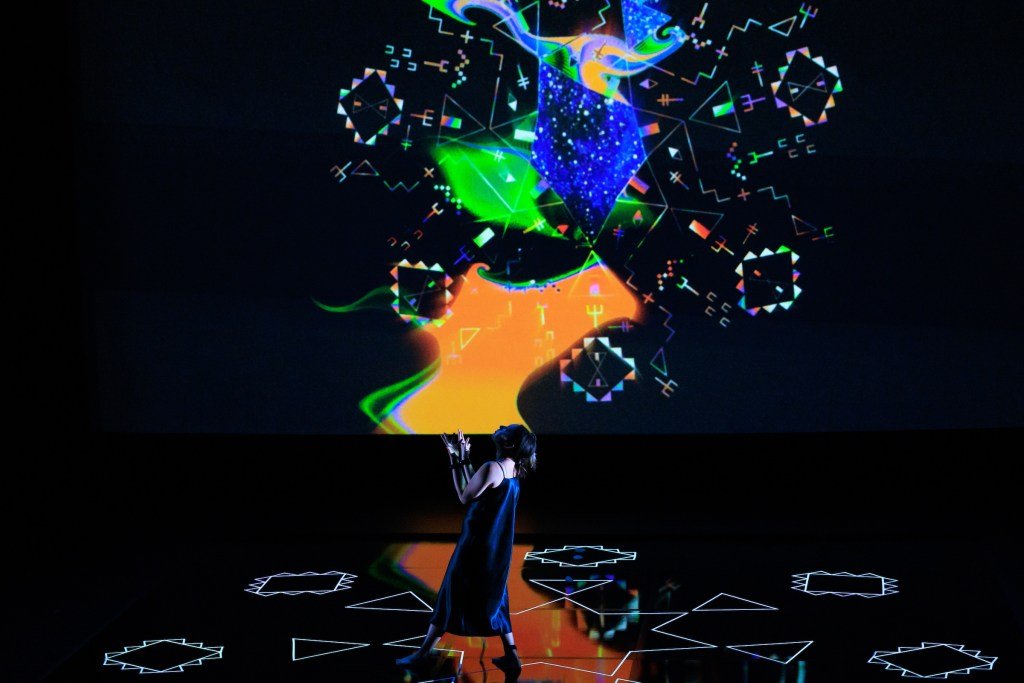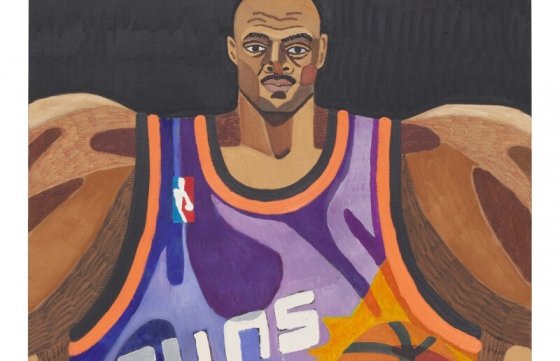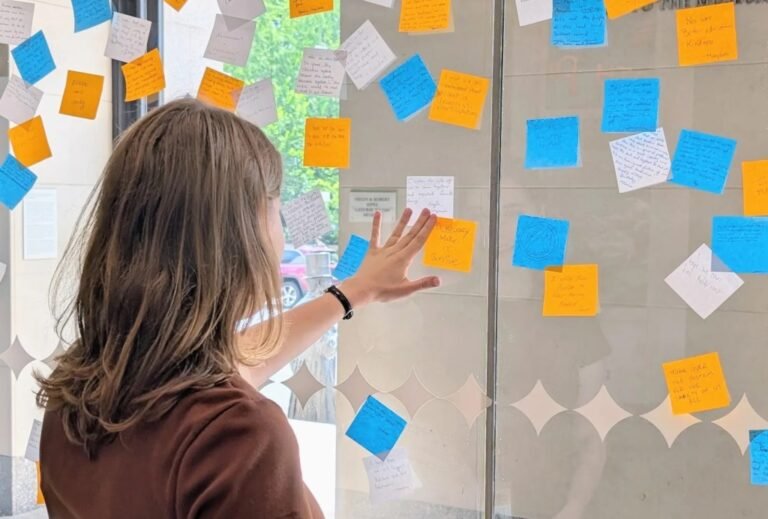

‣ Climate historian Amelia Urry meditates on the visual patterns of fractals in nature, from waves to glaciers, and what they tell us about chaos. For Atmos, she writes:
No one but a mathematician or a climate modeler is likely to mistake a cloud for a sphere, and yet natural forms’ simple defiance of standard geometry is indeed remarkable. Clouds, mountains, and lightning look jagged and uneven, yet they are not without their own species of order. Mandelbrot coined the term “fractal” for these shapes that seem to subvert Euclidean lines while concealing deeper kinds of symmetry. The forces governing the formation of these natural fractals are often very simple—the random wandering of a particle or the repetitive force of a drip of water—but repeated iteratively, they can form patterns of near-infinite complexity.
Fractals are self-similar, which is to say, their parts resemble the whole. Imagine each letter in the word “fractal” was formed by a smaller line of text spelling out the word “fractal.” Each letter of those small words would be made up of a further “fractal,” and on and on. The closer you look, the more you see: an infinite lacework repeating and repeating and repeating itself. Thus, the branches of a tree resemble smaller trees, each containing further branchings and copies.
‣ Last week, two curators opened a show of their brimming archive of artwork by trans women in Mexico City. Photographer Oscar Díaz interviews the curators for Them about what it means to cultivate an archive that is unmistakably alive:
And in this current exhibition, there are a variety of experiences across generations illuminating that. How did Plasticidades Encarnadas emerge after decades of indifference, violence, and cultural erasure that have weighed on so many trans women?
R.G.: One thing: the first edition of Plasticidades Encarnadas didn’t have a documentary approach. You couldn’t find photos with that nostalgic archival vibe that I hate. I hate exhibitions that are about trans women and focus on how they used to live. I think that anthropological gaze is completely outdated now. So in the first edition, instead of focusing on how trans women lived, we focused on what trans people do, their materiality and what they produce.
But when you are material you have to talk about process: how you reached that point of materialization. It was crucial that the first edition of Plasticidades move away from that anthropological view of “let’s see how trans people lived” and look instead at what trans people were doing. That’s why Plasticidades matters. It emerged at the same time as Archivo Trans México, but that archive focused on sequins [read: showgirls and nightlife]; Plasticidades Encarnadas was another conversation.
Even though some of the artists in Archivo Trans also appear in Plasticidades Encarnadas, we don’t share the same curatorial axis; we’re standing elsewhere.
‣ The Palestine Museum in Connecticut has just opened an outpost in Scotland, building upon its mission to support Palestinian artists around the world amid relentless attacks and censorship, Founder Faisl Saleh tells the Middle East Monitor:
Indeed, the Palestine Museum is no ordinary art museum. While it proudly showcases contemporary Palestinian art, from the hauntingly expressive to the defiantly hopeful, it also offers something increasingly rare: a platform where Palestinian culture, history and resistance can be centred without apology or censorship.
That commitment has become ever more urgent. In the wake of Israel’s ongoing genocide in Gaza, and a relentless campaign of forced displacement and settlement expansion in the occupied West Bank, the lines between humanitarian crisis, cultural erasure and political suppression have blurred. Yet cultural and academic institutions in Europe and the United States often remain silent—or actively suppress Palestinian voices.
A case in point occurred just last month when Dr Karameh Kuemmerle, a Palestinian American physician and one of the founders of Doctors Against Genocide, was invited to speak at Quinnipiac University about the medical realities unfolding in Gaza. But the university’s administration abruptly cancelled her talk, deeming the subject ‘too political’.
The Palestine Museum stepped in. Dr Kuemmerle delivered her talk at the museum instead to a packed audience, with the entire event now available on the museum’s YouTube channel.
This was more than a relocation, it was a statement. The museum is making room for Palestinian voices, no matter how uncomfortable it might be for some.
‣ Scholar Dana A. Williams recently wrote a book about Toni Morrison’s career as an editor at Random House, where she worked on manuscripts including sculptor Barbara Chase-Riboud’s poetry collection. Williams writes the late luminary and her razor-sharp eye for detail in Slate:
“Isn’t this book stunning? It’s just beautiful,” she said. The cover featured a striking silhouette of an African profile rendered entirely in black, set against a deep purple background.
When Ms. Morrison asked if I had seen the book before, I admitted that I had not. She handed it to me for what I considered to be an opportunity for redemption. If I could offer a close reading of the image, that might compensate for my embarrassment.
The profile was ungendered, I suggested. “Intentional,” she announced. “Gender could be such a silly distraction.” I pointed out the necklaces, which reinforced a sense of tradition, heritage, and pride in African culture. Yes. Was the profile of an African from the Maasai people, known for their elongated earlobes? Right again, she affirmed, my confidence building with each knowing nod. What was in the African’s earlobe? Was it a cigar tube case, a relic of colonialism; or was it another artifact meant to symbolize a scroll, quietly affirming the fact that African writing systems predated colonialism? As I marveled at the image, agreeing that the cover was as handsome as she had initially suggested and noting that it had layers upon layers, the point had been made: Every detail mattered.
This unyielding attention to detail was among the most enduring features of her editorship and accounted for so much of her success at Random House. Not long after moving to Manhattan from Syracuse—where she’d worked at the L.W. Singer Company, a small press that specialized in textbooks—she became the lone Black editor at prestigious Random House. This single mother of two could not afford missteps. She intended to excel both as a writer and as an editor. From a book’s cover and every sentence within it to the book’s promotional strategy, she left nothing to chance.
She worked closely, for example, with the jacket designer for From Memphis & Peking, a poetry collection by sculptor-turned-poet Barbara Chase-Riboud. When Chase-Riboud expressed concern about an early draft of the book’s layout Morrison shared, Morrison noted that she and the designer had talked about every detail of the book. “I never worked with a designer who was such a perfectionist,” she wrote. “You are not the French lady poet—he is!” Morrison knew that Chase-Riboud’s first literary achievement would need to be rendered as artistically as possible, as a way of introducing her new genre to her existing visual-art audience.
‣ Zohran Mamdani continues to gain traction in the New York mayoral primary, but for New Lines Magazine, author and journalist Yashica Dutt digs deeper into how different South Asian groups and communities are engaging with his campaign:
Mamdani’s team of 30,000 volunteers, who, according to the campaign, have knocked on over 890,000 doors since the start of this year (along with South Asian-focused organizations like DRUM Beats, CAAAV Voice and Muslim Democrats of City of New York) are attempting to move past the gatekeepers who have traditionally steered South Asian votes in New York, and it seems to be working.
During my reporting in Kensington and Midwood in Brooklyn, I met with dozens of immigrant Pakistani and Bangladeshi women who admitted to not being politically engaged in their home countries yet felt motivated to canvass for Mamdani. According to the 2023 NYC Communities of Interest report issued by the City University of New York (CUNY), Bangladeshis and Pakistanis have poverty rates of 22% and 21%, respectively — higher than the 19% rate citywide. Many believe Mamdani would be an effective mayor because he is a Muslim South Asian candidate who is “one of their own” and would intrinsically understand their issues, whether about immigration, affordability or solidarity with Palestine. Mamdani’s now-viral confrontation in March with Tom Homan, the Trump administration’s “border tsar,” over the detainment of the Columbia University graduate Mahmoud Khalil was brought up by many of these women, who are currently experiencing a rise in fear within their communities, with many refusing to leave their homes due to a spate of arrests by U.S. Immigration and Customs Enforcement (ICE) personnel.
‣ Earlier this month, 18 universities signed an amicus brief in support of Harvard’s lawsuit against the Trump administration’s funding cuts, with two names noticeably absent from the list: Columbia and Cornell. Joseph Zuloaga writes for the Columbia Daily Spectator:
The amicus brief states that federal funding cuts at Harvard “inflict grievous harm that extends well beyond Harvard University,” and describes academic research as an “interconnected enterprise.”
“The elimination of funding at Harvard negatively impacts the entire ecosystem,” the brief reads. “The cuts will disrupt ongoing research, ruin experiments and datasets, destroy the careers of aspiring scientists, and deter long-term investments at universities across the country.”
International student enrollment has also become a flash point in the government’s ongoing scrutiny of universities.
‣ Social media has officially overtaken television as Americans’ go-to news source, Michael Savage reports for the Guardian:
The findings confirm the huge changes taking place in news consumption worldwide. “The rise of social video and personality-driven news represents another significant challenge for traditional publishers that are struggling to adapt their content and tone to these very different environments,” said Nic Newman, a founding member of the BBC News website and the study’s lead author.
“Online video may be a good way to engage younger audiences, but there is very little commercial upside for publishers, with most news consumption taking place via platforms rather than owned and operated news websites. Publishers also face a loss of influence, with populist politicians increasingly looking to bypass scrutiny by working with sympathetic influencers instead.”
‣ The em dash — that ever-contentious punctuation mark — is back under scrutiny after people quickly picked up on the fact that it’s a sign of ChatGPT’s handiwork. Salon‘s Andi Zeisler explains:
Em dashes are among the most writerly of punctuation marks precisely because they don’t really need to be there. Unlike periods and commas, em dashes aren’t integral to sentence structure; they’re a considered choice that can, but by no means have to, take the place of commas, parentheses and semicolons. They are deployed for pauses and interruptions in speech; they precede bursts of exposition, neat summings-up and lengthy tangents. In internal and external dialogue, they can convey impatience, distraction, delirium, ecstasy. They aren’t always dramatic, but they are decidedly extra.
Accordingly, many writers have made style-defining use of them. In the poems of Emily Dickinson, em dashes signpost alertness and urgency as they halt sentences and leave readers hanging at the ends of lines, hoping for a resolution. James Joyce’s “Ulysses” rained em dashes on winding sentences that he had already stripped of quotation marks, resulting in prose so unruly that numerous reading groups are devoted specifically to parsing it. Vladimir Nabokov flexed on both of them by using em dashes between other em dashes.
And writers’ enthusiasm for em dashes is often hard-won, given that plenty of editors and readers would be happy to vanquish those ostentatious marks from the page entirely. Strunk and White’s “The Elements of Style” recommends restraint with what it calls “a dash,” cautioning that it should be used “only when a more common mark of punctuation seems inadequate.” Random House vice president, executive managing editor, and copy chief Benjamin Dreyer, in his contemporary style handbook “Dreyer’s English,” broaches the topic by writing tartly: “Likely you don’t need much advice from me on how to use em dashes, because you all seem to use an awful lot of them.” Overdashing New York Times writers were publicly rebuked by standards editor Philip B. Corbett in a 2011 post on the outlet’s blog that clocked a single-day total of 16 dashes on A1 alone. Even Dickinson’s dashes were erased from early publications of her work by editors who assumed readers would find them confusing.
‣ What excellent boiled potatoes! (iykyk):
‣ Pigeons contain multitudes!
Required Reading is published every Thursday afternoon, and it is comprised of a short list of art-related links to long-form articles, videos, blog posts, or photo essays worth a second look.


